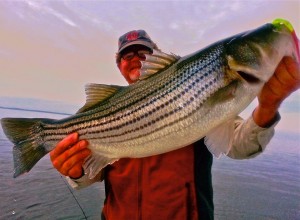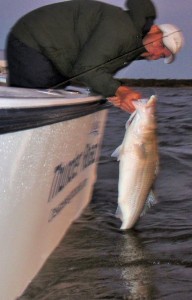patterns
 One of the more frequently asked questions I get whether by email or in person is, “How can I consistently catch bigger fish?” I’ve written about moving your game up to the next level before, but since we now have some migratory stripers in the Maryland part of the Chesapeake Bay, it’s worthwhile to address it again. The learning curve gets a little shorter in the fall and it’s a great chance to sharpen your skills. I’ll start by saying there are no hard and fast rules for catching stripers. Over my years of casting for them I feel like I’ve honed my techniques so that, on any given day, I have an edge for catching a trophy. That said, I’m still frequently surprised when a huge striper is caught by some completely different method than I’ve seen before. One thing is for sure, things change. There’s no substitute for experience but anglers who aren’t willing to stay on top of the latest innovations and newest techniques are certain to be left behind. Read More!
One of the more frequently asked questions I get whether by email or in person is, “How can I consistently catch bigger fish?” I’ve written about moving your game up to the next level before, but since we now have some migratory stripers in the Maryland part of the Chesapeake Bay, it’s worthwhile to address it again. The learning curve gets a little shorter in the fall and it’s a great chance to sharpen your skills. I’ll start by saying there are no hard and fast rules for catching stripers. Over my years of casting for them I feel like I’ve honed my techniques so that, on any given day, I have an edge for catching a trophy. That said, I’m still frequently surprised when a huge striper is caught by some completely different method than I’ve seen before. One thing is for sure, things change. There’s no substitute for experience but anglers who aren’t willing to stay on top of the latest innovations and newest techniques are certain to be left behind. Read More!
 Since I’ve reported bigger fish on recent trips, I’ve been overwhelmed with questions from fishermen who want to know where the fish are. The big fish are moving around very quickly and they are rarely at the same place twice. Even on days when I find them right back where I left them, they’ve been very wary and hard to catch. It’s been a challenging season, but if you look at my mid-October fishing reports from last year, you’ll see that the pattern is nearly the same. I think we sometimes put too much emphasis on locations, and not enough on patterns. Tell someone where to go to catch a fish and you may help them for a day, but teach them how to identify specific patterns in how fish behave, and you’ve helped them for a lifetime. Ask any accomplished fisherman the secret to repeated success and he’ll tell you it’s the ability to identify specific feeding patterns. I believe that you can drop a good fisherman into any body of water in the world and he’ll catch fish as long as you give him enough time to recognize the prevailing pattern. It’s especially important on the Chesapeake where circumstances change quickly and rapid drops in water temperature are not unusual in October. I think fishing conditions shift faster and more often here than anywhere I’ve fished before. Fortunately, fish are creatures of habit and there are distinct patterns to their behavior.
Since I’ve reported bigger fish on recent trips, I’ve been overwhelmed with questions from fishermen who want to know where the fish are. The big fish are moving around very quickly and they are rarely at the same place twice. Even on days when I find them right back where I left them, they’ve been very wary and hard to catch. It’s been a challenging season, but if you look at my mid-October fishing reports from last year, you’ll see that the pattern is nearly the same. I think we sometimes put too much emphasis on locations, and not enough on patterns. Tell someone where to go to catch a fish and you may help them for a day, but teach them how to identify specific patterns in how fish behave, and you’ve helped them for a lifetime. Ask any accomplished fisherman the secret to repeated success and he’ll tell you it’s the ability to identify specific feeding patterns. I believe that you can drop a good fisherman into any body of water in the world and he’ll catch fish as long as you give him enough time to recognize the prevailing pattern. It’s especially important on the Chesapeake where circumstances change quickly and rapid drops in water temperature are not unusual in October. I think fishing conditions shift faster and more often here than anywhere I’ve fished before. Fortunately, fish are creatures of habit and there are distinct patterns to their behavior.


